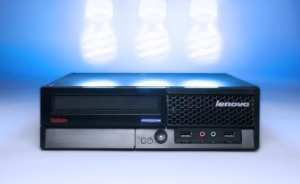Lenovo launches green (and small) desktop

Lenovo is claiming that its latest desktop is the smallest, quietest and most energy efficient. Will it be enough to make desktops cool again?
Probably not since most folks are replacing desktops with laptops, but give Lenovo (all reviews) credit for trying.

Lenovo (statement) is obviously going for the green crowd with this PC, it cites designations from the Green Electronics Council in its release. Lenovo also notes that the A61e uses 90 percent reusable material and 90 percent recyclable packaging. It can also be powered by an optional solar panel. The desktop also surpasses the EPA's Energy Star 4.0 criteria.
Among the key specifications:
- The ThinkCentre A61e has two chip choices, a 45-watt AMD Athlon 64 X2 dual core and AMD Sempron single core processor;
- The desktop is 25 percent smaller than previous models and weighs in at 8 pounds.
- The desktop has a single low-speed fan.
The Chinese PC giant also hits hard with the energy savings claims. Lenovo claims that the A61e can cut energy costs in half.
For example, Lenovo says the A61e can save $20 a year in energy costs for a single user--don't laugh that's the "equivalent of the carbon dioxide emissions created by two round-trip plane flights from Boston to New York."
Obviously, these numbers add up the more PCs you deploy. Fifty desktops would save more than $1,000 a year and 20,000 pounds of carbon dioxide emissions and 50,000 desktops would save you $1 million in energy costs.
And if you're wondering how Lenovo cooked up those figures, here's the handy footnote.
The figures are "based on Lenovo and TBR calculations using a single AMD Athlon 64 X2-based processor. Based on a 5% per year increase in electricity rates and on a daily PC usage pattern that includes 70% of time spent in sleep state, 5% of time spent in idle and 25% of time spent in an operational state. Average electricity price based on American 2007 average retail price 8.37 cents per kilowatt hour."